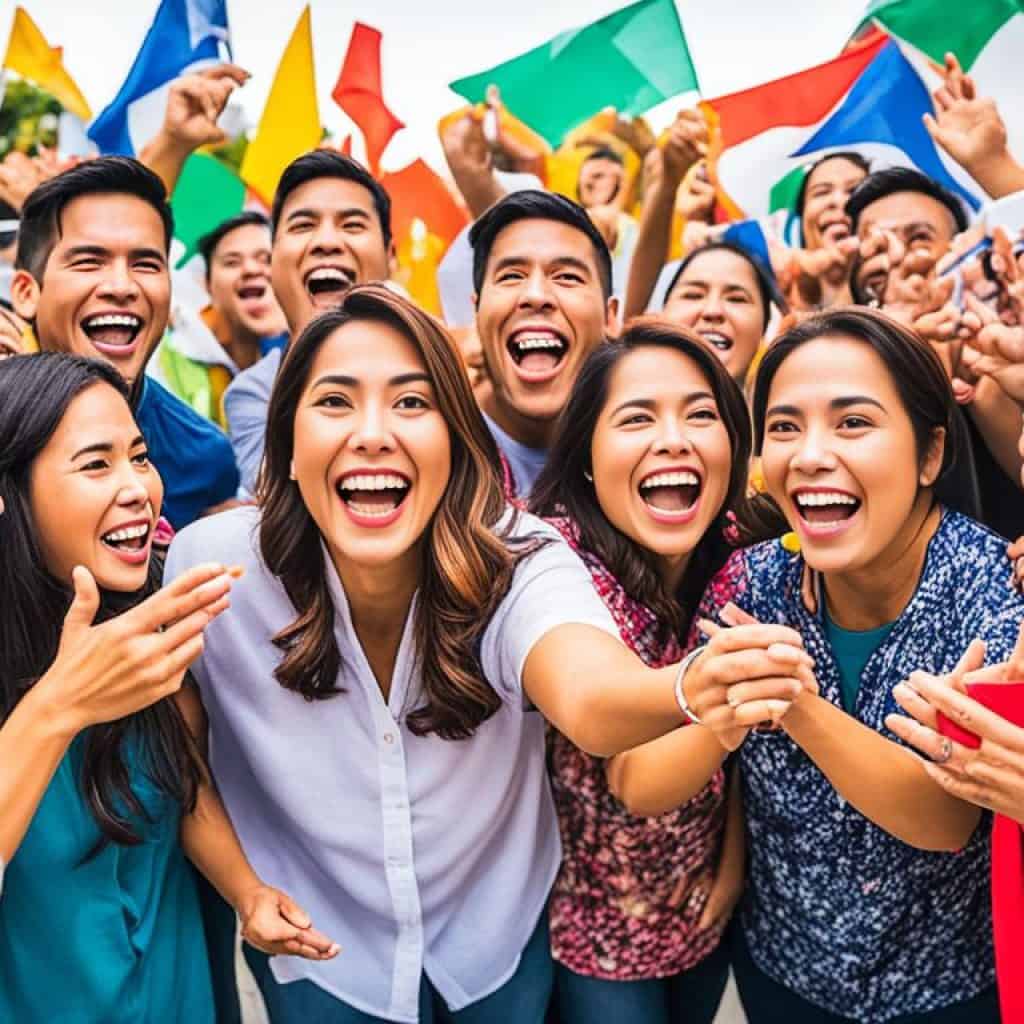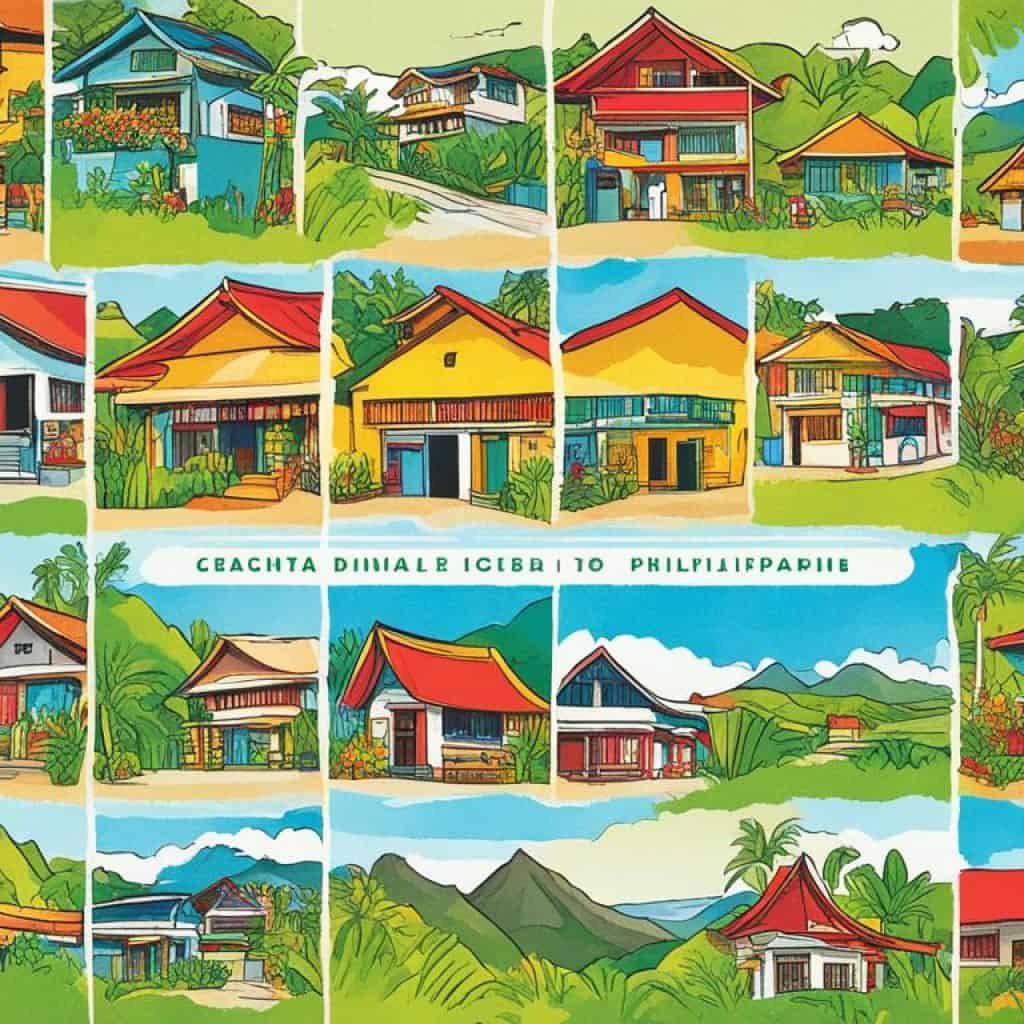Did you know the Philippines boasts 183 live languages? This includes the official languages of Filipino and English. There are also regional dialects like Tagalog to explore. But what’s the main language spoken?
Is it Filipino or Tagalog? Let’s dig into the Philippines’ language essentials and explore its rich linguistic landscape.
Key Takeaways:
- The Philippines has 183 live languages, but Filipino and English are the official languages.
- Tagalog, a dialect spoken by approximately 14 million people, is the foundation of the Filipino language.
- Spanish influence is still evident in Filipino vocabulary and culture.
- English is widely spoken in the Philippines and plays a significant role in education and business.
- Learning Filipino greetings can help you connect with locals and immerse yourself in Filipino culture.
Linguistic Diversity in the Philippines
The Philippines is proud of its linguistic diversity. It has 183 living languages, making it one of the most linguistically diverse countries. Most of these languages are indigenous, showing the unique cultural heritage of the nation.
There’s an 80% chance that two Filipinos might speak different languages. This shows the rich mix of languages and dialects among its people.
Every August, the Philippines celebrates its languages through the Buwan ng Wika. This event honors and promotes the country’s various languages. It’s a month-long celebration of language diversity.
“Languages are the foundation of cultural identity. The linguistic diversity in the Philippines is a testament to the vibrant tapestry of cultures and traditions that exist within our country.” – Dr. Maria Pangilinan, Linguistics Professor
The Role of Language in Filipino Society
The languages of the Philippines reflect its rich culture and heritage. They carry traditional songs, dances, and stories. They play a key role in keeping cultural knowledge alive across generations.
Language helps connect and understand the diverse communities in the nation. It brings people together.
| Language | Region | Number of Native Speakers |
|---|---|---|
| Tagalog | Luzon | 14 million |
| Cebuano (Bisaya) | Visayas and Mindanao | 21 million |
| Hiligaynon (Ilonggo) | Western Visayas | 9.1 million |
| Ilocano | Ilocos Region | 9.1 million |
| Bicolano | Bicol Region | 4.5 million |
Different languages in the Philippines show its multicultural society and regional identities.
Although Filipino and English are the official languages, appreciating all languages helps us understand and enjoy the Philippines’ rich culture.
Spanish Influence in the Philippines
The Philippines has a rich history with Spain that still affects the country today. From 1565 to 1898, it was a Spanish colony. Even though Spanish isn’t the official language anymore, its impact is visible in Filipino language, food, religion, and buildings.
Spanish loanwords are a big part of the Filipino language. About a third of Filipino vocabulary comes from Spanish. These words are now key parts of daily speech in the Philippines.
“Spanish has contributed to the richness and diversity of the Filipino language. Many commonly used words in Filipino, such as kusina (kitchen), mesa (table), and libro (book), are derived from Spanish.”
Spanish rule also brought Catholicism to the Philippines. Today, it’s the main religion. Many local traditions and religious practices have Spanish origins.
Spanish architectural styles are seen in churches, forts, and old homes from that era.
Though time has passed, Spain’s impact during colonial times still shapes Philippine identity today. Only a small fraction speaks Spanish now. Yet, its cultural and linguistic effects are clear.
Spanish Influence in Filipino Cuisine
The influence of Spain on Filipino food is strong. Many Filipino dishes come from Spanish cuisine or use Spanish ways of cooking. Dishes like adobo, caldereta, paella, and lechon show this blend.
| Spanish Influence in Filipino Cuisine | Spanish Origin or Ingredient |
|---|---|
| Adobo | A dish marinated in vinegar, soy sauce, garlic, and spices, similar to the Spanish adobo. |
| Caldereta | A stew made of meat, vegetables, and tomato sauce, introduced by Spanish settlers. |
| Paella | A rice dish with saffron, vegetables, and various meats or seafood, adapted from the Spanish paella. |
| Lechon | A whole roasted pig, influenced by the Spanish tradition of roasting suckling pigs. |
This mixture of Spanish and Filipino tastes has created a distinct and diverse culinary culture.
In summary, Spain’s rule has permanently marked the Philippines, touching its language, culture, religion, architecture, and food. Even with less Spanish spoken, its legacy is evident in everyday Filipino life, through words, food, and traditions passed down through generations.
Filipino and English as Official Languages
In the Philippines, Filipino and English are official languages. Filipino is the national language, rooted in Tagalog. English gained its status during the US colonial era and is used in government, schools, and the media.
Filipino connects people from different linguistic backgrounds. It’s a common language for everyday talk. It combines words from Tagalog, Spanish, English, Chinese, and Malay.
English is essential in professional and formal settings. It’s used in government, education, business, and media. Filipinos’ good English skills make the country a leading place for call centers and related industries.
| Filipino | English |
|---|---|
| Based on Tagalog | Adopted from the United States |
| National language | Widely used in official and formal settings |
| Acts as a lingua franca | Key language for business, education, and media |
| Incorporates loanwords from various languages | Has a significant influence on the Filipino vocabulary |
Tagalog as a Major Language in the Philippines
Tagalog is a key member of the Austronesian language family. It’s the basis for the Filipino language, the national language of the Philippines. It’s mainly spoken in central Luzon and parts of Mindanao by about 14 million people. Tagalog forms the second largest language and cultural community in the Philippines. It adds to the country’s rich linguistic and cultural diversity.
The Tagalog dialect is known for its complex verbal system. This system is crucial for expressing subtle differences and sharing complex ideas. The grammar and vocabulary of the Filipino language are greatly influenced by Tagalog. This shows Tagalog’s significant role in the Philippine’s linguistic landscape.
“Tagalog, as both a dialect and a cultural heritage, plays a significant role in shaping the Filipino identity and fostering unity among Filipinos.”
Tagalog and Filipino: Interwoven Languages
Tagalog has been vital in developing Filipino, the national language of the Philippines. Filipino is a standardized version of Tagalog. It’s enriched by borrowing from other Philippine languages, as well as Spanish, English, Chinese, and Malay. While Filipino and Tagalog are not the same, they are close enough to allow easy communication between speakers of both languages.
The renaming of Tagalog to Filipino in 1973 marked a significant shift. This change aimed at highlighting the language’s inclusivity. It reflects the diverse cultures of the Filipino people across the nation.

Comparing Tagalog and Filipino
| Tagalog | Filipino |
|---|---|
| Primarily spoken in central Luzon and parts of Mindanao | Nationally recognized and serves as the lingua franca |
| Approximately 14 million native speakers | Spoken by more than 100 million Filipinos |
| Influential in shaping Filipino vocabulary and grammar | Enriched by incorporating elements from various Philippine languages, as well as Spanish, English, Chinese, and Malay |
| Recognized as a major language and cultural community | Reflects the multicultural identity of the Philippines |
While Filipino and Tagalog have their unique features, they share a deep connection. This connection intertwines their histories and cultural importance. Both languages are dear to Filipinos, symbolizing their shared history and uniting people across the islands.
Filipino vs. Tagalog
Filipino and Tagalog might seem the same, but they’re not. Filipino is Tagalog but updated. It includes words from other languages in the Philippines, plus from Spanish, English, Chinese, and Malay. Both Filipino and Tagalog are easy to understand for speakers of the other. The name Tagalog changed to Filipino in 1973, becoming an official language in 1987.
Tagalog is mainly spoken in central Luzon and some parts of Mindanao. Around 14 million people speak it as their first language. It’s the base for Filipino, the country’s national language.
Tagalog was renamed Filipino in 1973 and granted official language status in 1987.
Filipino is like the newer model of Tagalog. It has picked up words and grammar from other Philippine languages. It also reflects the Philippines’ diverse culture by including Spanish, English, Chinese, and Malay influences.
When Tagalog turned into Filipino, it was the government’s way of uniting different language speakers. Filipino aims to connect all the linguistic communities in the Philippines. It’s about bringing people together.
Having Filipino and English as official languages shows how the Philippines values being bilingual. English is used in schools, the government, and media. Filipino is the common tongue that unites everyone across the islands.
The Similarities and Differences Between Filipino and Tagalog:
1. Vocabulary: Filipino and Tagalog share lots of words. But Filipino has more, borrowing from other Philippine languages and abroad.
2. Grammar: The grammar in both languages is pretty similar, because Filipino is based on Tagalog. They use word changes to show grammar and meaning.
3. Intelligibility: If you speak one, you can understand the other. This makes it easy for Filipinos from different areas to talk to each other.
4. Usage: Filipino is what schools use and what’s used in official settings. Tagalog is more for everyday talk in certain areas.
5. Regional Variants: Tagalog varies by region, but Filipino tries to be standard. It mixes features from across the Philippines.
The bond between Filipino and Tagalog shows the Philippines’ complex language scene. Filipino represents the country’s many voices, while Tagalog holds onto its local importance. Understanding both connects you more deeply with Filipinos and their traditions.
English in the Philippines
English is a key language in the Philippines. It is one of the official languages. Most people there speak it well. English has been important since the American colonial period.
The country is known for its English fluency. This has made it a top place for call centers. Good English skills help in business and tourism.
Many Filipinos are great at English. This success comes from strong education in the language. Knowing English well opens global doors. It also helps Filipinos appreciate Western culture more.
“English language proficiency is a valuable asset for Filipinos, enabling them to engage confidently with people from around the globe.”
The Philippines focuses on teaching English early in school. Students work on speaking, listening, reading, and writing. This has helped the country be known for its English skills.
This skill in English makes the Philippines a top choice for business outsourcing. The call center industry benefits from good English and low costs.
But English in the Philippines isn’t just for business. It’s also common in media, entertainment, and schooling. It connects different groups and helps unite the country.
English proficiency brings economic and cultural benefits to the Philippines. It helps link Filipinos to the wider world. It allows for sharing ideas and values.
To sum up, being good at English is very valued in the Philippines. It is used a lot, brings jobs, and has cultural importance. For Filipinos, it’s a key way to connect with others and has shaped the country today.
Learning English in the Philippines
If you want to learn English, the Philippines is a great choice. It’s known for its strong English fluency and cost-effective ESL programs. This makes it a top pick for students looking to study in a beautiful setting.
In-Person Courses
Prefer to learn in a classroom? Cities like Cebu, Manila, and Boracay offer in-person courses. These places have language academies with skilled teachers. You get to improve your English while experiencing the local culture.
Online Courses
Online courses offer flexibility. Platforms like FutureLearn have various English courses that you can do at home. These courses are interactive and led by dedicated teachers, allowing you to learn at your own speed.
Learning English in the Philippines has become increasingly popular due to the country’s reputation for English fluency and affordable ESL programs.
The Benefits
Learning English in the Philippines has many perks. You’ll join a community of English learners and speakers. This is great for practice. Plus, the country’s friendly culture makes it a welcoming place for students.
Opportunities for Immersion
In the Philippines, you’ll get to use English in real-life situations. This could be when ordering food or visiting tourist spots. Such hands-on experiences will boost your confidence in speaking English.
Other Major Languages in the Philippines
The Philippines is rich in languages besides Tagalog and English. These are spoken in different regions. They show the country’s rich heritage and cultural diversity. By learning about these languages, we grow to appreciate the culture even more. Let’s look at some:
Cebuano (Bisaya)
Cebuano, or Bisaya, is mainly used in the Visayas region. It’s the second most common language there. Millions speak it, and it has a rich literary tradition.
Hiligaynon (Ilonggo)
Hiligaynon, or Ilonggo, is widely spoken in Western Visayas. Its melodic sound is distinctive. It’s used in Panay and Negros Occidental, rich in proverbs and folk songs.
Ilocano
Ilocano ranks third among the Philippines’ languages. It’s primarily spoken in the Ilocos Region in Northern Luzon. Famous for its poetry, it’s vital in Philippine literature.
Bicolano
Bicolano is used in the Bicol Region. It stands out for its unique accent and intonation. Central Bicolano is the most common variant, deeply influencing the area’s culture.
Waray
Waray is spoken mainly in Eastern Visayas, like Samar and Biliran. Noted for its oral traditions like epic poetry. It adds to the Philippines’ linguistic diversity.
Pangasinan
Pangasinan language is one of the oldest in the Philippines. It’s spoken in the Pangasinan province. Known for its poetry, songs, and rituals, it’s also officially recognized.
Maguindanao
Maguindanao is spoken by the Maguindanaoan people in the South. Most speakers are in Maguindanao province and parts of ARMM. It carries strong historical and cultural significance.
Kapampangan
Kapampangan is used in Pampanga and nearby regions. Known for its expressive style, it has a unique pitch. Its culture is rich with cuisine, arts, and music.
| Language | Region |
|---|---|
| Cebuano (Bisaya) | Visayas Region |
| Hiligaynon (Ilonggo) | Western Visayas Region |
| Ilocano | Ilocos Region, Northern Luzon |
| Bicolano | Bicol Region, Luzon |
| Waray | Eastern Visayas Region |
| Pangasinan | Pangasinan Province, Luzon |
| Maguindanao | Maguindanao Province, ARMM |
| Kapampangan | Pampanga Province, Luzon |
These languages show the Philippines’ amazing linguistic diversity. Each language reflects the country’s rich culture and the harmony among its communities. Understanding these languages helps unite and appreciate the Philippines’ diverse culture.

Filipino Greetings in Different Languages
The Philippines is a place of many cultures, with people who speak various languages. Whether you’re going to Luzon, Visayas, or Mindanao, knowing some basic greetings in different languages can make your trip richer. Here are some common greetings in languages from the Philippines:
1. Tagalog (Filipino)
Magandang araw! – Good day!
2. Cebuano (Bisaya)
Maayong buntag! – Good morning!
3. Ilonggo
Maayong adlaw! – Good day!
4. Ilocano
Naimbag a bigat! – Good morning!
5. Bicolano
Marhay na aga! – Good morning!
Language Greeting Tagalog (Filipino) Magandang araw! Cebuano (Bisaya) Maayong buntag! Ilonggo Maayong adlaw! Ilocano Naimbag a bigat! Bicolano Marhay na aga!
These greetings help you meet people in different parts of the country. They show you respect the local culture and create a good impression. Remember, a kind greeting can help form friendships and make your stay in the Philippines more memorable.
Cultural Significance of Greetings in the Philippines
Greetings are crucial in Filipino culture. They reflect the people’s warmth and hospitality. Filipinos are friendly and welcoming, and they often greet with a smile. The right greeting shows respect and friendliness.
Greetings help connect with others, locals or foreigners. Greeting someone shows you see them and value their company. This creates a friendly atmosphere right away.
In the Philippines, there are many greetings for different times. “Magandang araw!” means “Good day!” and works any time. “Kamusta?” means “How are you?” and shows care for the person’s well-being.
Greeting with respect and the right words shows warmth in Filipino culture. It connects people and makes interactions meaningful.
Physical gestures like handshakes or nods are also common in greetings. These gestures show respect and add to the friendly vibe.
Using Filipino greetings enhances your visit, whether for business or fun. It shows you respect local customs. It helps make meaningful connections with the locals.
The image below shows the vibrant Filipino culture where greetings are key to connecting people:
Traditional Filipino Greetings
Here are traditional Filipino greetings in several languages:
| Language | Greeting |
|---|---|
| Tagalog | Magandang araw! |
| Cebuano | Maayong buntag! |
| Ilonggo | Maayong adlaw! |
| Ilocano | Naimbag a bigat! |
| Bicolano | Marhay na aga! |
These greetings let you connect across the Philippines. They show the country’s rich language diversity.
Challenges and Opportunities of Learning Filipino Greetings
Learning Filipino greetings can be fun and opens doors to understanding Filipino culture. It enables meaningful connections with people from the Philippines. But, it also brings challenges, especially for those who are not native speakers.
The first challenge is getting the pronunciation and intonation right. Filipino greetings have unique sounds. Non-native speakers may find these sounds hard to imitate accurately. The best approach is listening carefully to native speakers. Then, practice a lot to get better at pronunciation.
“Learning how to greet someone in their own language is a sign of respect and appreciation.”
Understanding when to use Filipino greetings is another hurdle. There are greetings for different times of the day and specific ones for elders, formal, and informal settings. Knowing when and how to use these greetings takes cultural understanding. Yet, making the effort to learn these greetings shows you respect the local customs. It can lead to more meaningful talks.
Learning Filipino greetings offers great chances for cultural immersion and making new friends. Greeting someone in their language leaves a positive impression. It shows you care about their culture. This act can lead to deeper conversations and strong friendships.
So, face the challenges and grab the opportunities of learning Filipino greetings. Dive into Filipino language and culture. Listen to how native speakers talk, and keep practicing. Don’t worry about making mistakes. Filipinos will appreciate your efforts. They will help you learn their language.
Tips for Learning and Using Filipino Greetings
Want to connect with the Philippines’ vibrant culture? Learning Filipino greetings is a fantastic start. Here’s how to make your experience better:
- Practice pronunciation and intonation: Sounding natural in Filipino greetings depends on getting the pronunciation and intonation right. Listen to native speakers in recordings or videos. This helps you learn the correct way to say each word.
- Immerse yourself in the Filipino culture: Immersing in the Philippines’ rich culture helps you understand Filipino greetings better. Participate in local events, festivals, or language exchanges. Interacting more with native speakers improves your greeting skills in real situations.
- Don’t be afraid to make mistakes: Everyone makes mistakes when learning a new language. Don’t let the fear of imperfection stop you. Filipinos will appreciate your effort and support your journey. They’ll help you learn as you go.
“Learning and using Filipino greetings opens a door to connecting with the Philippines’ warm and hospitable people. Practice and immersion will soon have you greeting others confidently in their language.”
Remember, Filipino greetings are a vital part of the culture there. Using them shows respect and friendliness. So, dive in! Start using these greetings in your daily chats!
| Tip | Description |
|---|---|
| 1 | Practice pronunciation and intonation |
| 2 | Immerse yourself in the Filipino culture |
| 3 | Don’t be afraid to make mistakes |
Introduction to Filipino Cultural Etiquette
Filipino culture is rich with unique customs and etiquette. It reflects the values and traditions of the Filipino people. Knowing and respecting these cultural norms is crucial when meeting locals and diving into the vibrant Filipino community.
Respecting elders is a key cultural norm in the Philippines. Valuing elders and honoring parents and older relatives are important. When talking to older people, using “po” and “opo” shows respect.
Filipinos are known for their hospitality. They welcome guests warmly. Visitors are often offered food and drinks as a kind gesture.
“Respect for elders, showing hospitality, and using proper greetings are important cultural norms in the Philippines.”
Proper greetings are also essential in Filipino culture. A smile and the right greeting for the time show respect and friendliness. Using greetings like “Magandang araw” (Good day) in Tagalog, helps make connections.
Key Cultural Norms in the Philippines:
- Respect for elders
- Hospitality and generosity
- Appropriate greetings
- Value on personal relationships
- Emphasis on family and community ties
These cultural norms emphasize kindness and consideration. Filipinos cherish personal connections and strong family and community bonds. It’s key to build relationships based on respect and true care.
Learning about Filipino cultural etiquette enriches cultural experiences. It also helps make lasting friendships with the Filipino people.
Conclusion
The Philippines is not just about beautiful sights and warm people. It is also a place of many languages. Filipino and English are the main languages. Filipino comes from Tagalog, and you can hear English everywhere. You’ll also find Spanish words mixed in.
When you use Filipino greetings, you connect with the culture and its friendly people. Diving into the country’s languages opens doors to its colorful culture. You’ll have better chats with the locals.
The languages in the Philippines, like Tagalog and Cebuano, show the country’s diverse traditions. Each region has its own story, reflected in its language. So, learning these languages lets you see the Philippines’ true beauty.







Add comment